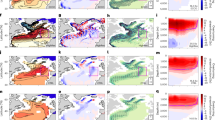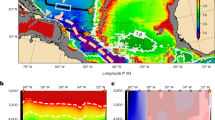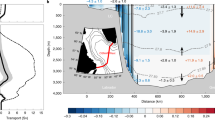Abstract
To understand how our global climate will change in response to natural and anthropogenic forcing, it is essential to determine how quickly and by what pathways climate change signals are transported throughout the global ocean, a vast reservoir for heat and carbon dioxide. Labrador Sea Water (LSW), formed by open ocean convection in the subpolar North Atlantic, is a particularly sensitive indicator of climate change on interannual to decadal timescales1,2,3. Hydrographic observations made anywhere along the western boundary of the North Atlantic reveal a core of LSW at intermediate depths advected southward within the Deep Western Boundary Current (DWBC)4,5,6,7,8,9. These observations have led to the widely held view that the DWBC is the dominant pathway for the export of LSW from its formation site in the northern North Atlantic towards the Equator10,11. Here we show that most of the recently ventilated LSW entering the subtropics follows interior, not DWBC, pathways. The interior pathways are revealed by trajectories of subsurface RAFOS floats released during the period 2003–2005 that recorded once-daily temperature, pressure and acoustically determined position for two years, and by model-simulated ‘e-floats’ released in the subpolar DWBC. The evidence points to a few specific locations around the Grand Banks where LSW is most often injected into the interior. These results have implications for deep ocean ventilation and suggest that the interior subtropical gyre should not be ignored when considering the Atlantic meridional overturning circulation.
This is a preview of subscription content, access via your institution
Access options
Subscribe to this journal
Receive 51 print issues and online access
$199.00 per year
only $3.90 per issue
Buy this article
- Purchase on Springer Link
- Instant access to full article PDF
Prices may be subject to local taxes which are calculated during checkout




Similar content being viewed by others
References
Lazier, J. Oceanographic conditions at ocean weather ship Bravo, 1964–1974. Atmos. Ocean 18, 227–238 (1980)
Rhines, P. B. & Lazier, J. R. N. A 13-year record of convection and climate change in the deep Labrador Sea. In Abstract Report of ACCP Principal Investigators Meeting (NOAA Office of Global Programs, 1995)
Lazier, J., Yashayaev, I., Rhines, P., Hendry, R. & Clarke, A. Convection and restratification in the Labrador Sea, 1990–2000. Deep-Sea Res. I 49, 1819–1835 (2002)
Talley, L. D. & McCartney, M. S. Distribution and circulation of Labrador Sea Water. J. Phys. Oceanogr. 12, 1189–1205 (1982)
Molinari, R. L., Fine, R. A. & Johns, E. The Deep Western Boundary Current in the tropical North Atlantic Ocean. Deep-Sea Res. 39, 1967–1984 (1992)
Pickart, R. S. Water mass components of the North Atlantic Deep Western Boundary Current. Deep-Sea Res. 39, 1553–1572 (1992)
Smethie, W. M., Fine, R. A., Putzka, A. & Jones, E. P. Tracing the flow of North Atlantic Deep Water using chlorofluorocarbons. J. Geophys. Res. 105, 14297–14324 (2000)
Stramma, L. et al. Deep water changes at the western boundary of the subpolar North Atlantic during 1996 to 2001. Deep-Sea Res. I 51, 1033–1056 (2004)
Rhein, M. et al. Labrador Sea Water: pathways, CFC inventory, and formation rates. J. Phys. Oceanogr. 32, 648–665 (2002)
Molinari, R. L. et al. The arrival of recently formed Labrador Sea Water in the Deep Western Boundary Current at 26.5° N. Geophys. Res. Lett. 25, 2249–2252 (1998)
Bryden, H. L., Johns, W. E. & Saunders, P. M. Deep Western Boundary Current east of Abaco: Mean structure and transport. J. Mar. Res. 63, 35–57 (2005)
Davis, R. E. The Autonomous Lagrangian Circulation Explorer (ALACE). J. Atmos. Ocean. Technol. 9, 264–285 (1992)
Lavender, K. L., Davis, R. E. & Owens, W. B. Mid-depth recirculation observed in the interior Labrador and Irminger seas by direct velocity measurements. Nature 407, 66–69 (2000)
Lavender, K. L., Owens, W. B. & Davis, R. E. The mid-depth circulation of the subpolar North Atlantic Ocean as measured by subsurface floats. Deep Sea Res. I 52, 767–785 (2005)
Fischer, J. & Schott, F. A. Labrador Sea Water tracked by profiling floats—from the Boundary Current into the open North Atlantic. J. Phys. Oceanogr. 32, 573–584 (2002)
Schott, F. A. & Brandt, P. in Ocean Circulation: Mechanisms and Impacts (eds Schmittner, A., Chiang, J. C. H. & Hemming, S.) 95 (American Geophysical Union, 2007)
Getzlaff, K., Boening, C. W. & Dengg, J. Lagrangian perspectives of deep water export from the subpolar North Atlantic. Geophys. Res. Lett. 33 L21S08 10.1029/2006GL026470 (2006)
Rossby, H. T., Dorson, D. & Fontaine, J. The RAFOS system. J. Atmos. Ocean. Technol. 3, 672–679 (1986)
Boening, C. W., Scheinert, M., Dengg, J., Biastoch, A. & Funk, A. Decadal variability of subpolar gyre transport and its reverberation in the North Atlantic overturning. Geophys. Res. Lett. 33, L21S01 (2006)
Lozier, M. S. Evidence for large-scale eddy-driven gyres in the North Atlantic. Science 277, 361–364 (1997)
Lozier, M. S. The impact of mid-depth recirculations on the distribution of tracers in the North Atlantic. Geophys. Res. Lett. 26, 219–222 (1999)
Schmitz, W. J. & McCartney, M. S. On the North Atlantic Circulation. Rev. Geophys. 31, 29–49 (1993)
Hogg, N. G., Pickart, R. S., Hendry, R. M. & Smethie, W. J. The northern recirculation gyre of the Gulf Stream. Deep-Sea Res. 33, 1139–1165 (1986)
Kieke, D. et al. Changes in the CFC inventories and formation rates of Upper Labrador Sea Water, 1997–2001. J. Phys. Oceanogr. 36, 64–86 (2006)
Pacanowski, R. C. MOM 2 (Version 2.0) Documentation User’s Guide and Reference Manual, Geophys. Fluid Dynam. Lab. Ocean Technol. Rep. 3.1 329 (GFDL/NOAA, 1996)
Rossby, H. T. The North Atlantic Current and surrounding waters: at the crossroads. Rev. Geophys. 34, 463–481 (1996)
Kearns, E. J. & Rossby, H. T. Historical position of the North Atlantic Current. J. Geophys. Res. C 103, 15509–15524 (1998)
Zenk, W., Pinck, A., Becker, S. & Tillier, P. The Float Park: A new tool for a cost-effective collection of Lagrangian time series with dual release RAFOS floats. J. Atmos. Ocean. Technol. 17, 1439–1443 (2000)
Rio, M., Schaeffer, P., Lemoine, J. & Hernandez, F. Estimation of the ocean Mean Dynamic Topography through the combination of altimetric data, in-situ measurements and GRACE geoid: from global to regional studies. In Proc. of the GOCINA Int. Workshop (GOCINA, 2005)
Acknowledgements
We acknowledge the captains and crews of the R/V Oceanus and numerous Canadian fisheries research vessels, and scientists from the Northwest Atlantic Fisheries Centre in St. John’s, Newfoundland, for their assistance in the deployment of the floats and sound sources used in this study. In particular, we thank E. Colbourne for his support of the float release programme. We also acknowledge J. Valdes and B. Guest for their expert technical support in the preparation of the floats, and H. Furey for providing float tracking. J. Fischer of IFM-GEOMAR provided several days of ship time to replace sound sources. We dedicate this work to the memory of F. Schott. The work was supported by the US National Science Foundation.
Author Contributions A.S.B. and M.S.L. contributed equally to this work. A.S.B. led the RAFOS float field programme, and analysed the float and altimetric data. M.S.L. led the modelling study and with S.F.G. analysed the simulated trajectories. C.W.B. provided the model output and assisted with the calculation of the simulated trajectories from FLAME.
Author information
Authors and Affiliations
Corresponding authors
Supplementary information
Supplementary Information
This file contains Supplementary Tables S1 and S2, Supplementary Data, Supplementary Figure S1 with Legend and Supplementary References. (PDF 197 kb)
Rights and permissions
About this article
Cite this article
Bower, A., Lozier, M., Gary, S. et al. Interior pathways of the North Atlantic meridional overturning circulation. Nature 459, 243–247 (2009). https://doi.org/10.1038/nature07979
Received:
Accepted:
Issue Date:
DOI: https://doi.org/10.1038/nature07979
This article is cited by
-
Wind-steered Eastern Pathway of the Atlantic Meridional Overturning Circulation
Nature Geoscience (2024)
-
The evolution of the North Atlantic Meridional Overturning Circulation since 1980
Nature Reviews Earth & Environment (2022)
-
Abyssal current and water mass in the Main Gap and an adjacent Small Gap of the Emperor Seamount Chain
Journal of Oceanography (2022)
-
Redrawing the Iceland−Scotland Overflow Water pathways in the North Atlantic
Nature Communications (2020)
-
Mechanisms of decadal variability in the Labrador Sea and the wider North Atlantic in a high-resolution climate model
Climate Dynamics (2017)
Comments
By submitting a comment you agree to abide by our Terms and Community Guidelines. If you find something abusive or that does not comply with our terms or guidelines please flag it as inappropriate.



